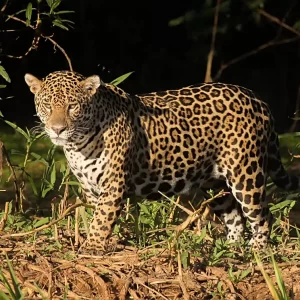The Pantanal is the world’s largest freshwater marsh ecosystem and is rightly famous for its world class wildlife watching opportunities. Located principally in the Brazilian states of Mato Grosso do Sul and Mato Grosso, the Pantanal extends into neighbouring Bolivia and Paraguay as well. Its global importance was officially recognized in 2000, when declared a UNESCO Biosphere Reserve. The Pantanal is home to an estimated 3,500 plant species, ca. 160 mammals, more than 300 fishes, and approximately 650 bird species.
In Brazil we divide the Pantanal broadly into two parts: the northern Pantanal, which for the purposes of birding and wildlife tours encompasses the Pantanal of Poconé and Porto Jofre, centred along the Transpantaneira, the Pantanal of Cáceres and the Paraguay river, and the Rio Mutum area near Barão de Melgaço; and the southern Pantanal, which actually includes most of the ecosystem, but for eco-tourism purposes usually refers to the areas accessed from Aquidauana, Miranda, and Corumbá. In fact, the Pantanal is comprised of 11 distinct sub-regions, each differing in its water table and flooding/drainage regimes, vegetation, soil composition, and topography.
The dry season (July to October) in the Pantanal presents one of South America’s great wildlife spectacles. By the end of the rainy season, the many rivers draining the Pantanal will have spilled over their banks, adding to the standing water which collects in the saturated, low-lying marshes. As the flood waters begin to recede, they leave behind newly nourised plant life and a renewed ecosystem. More importantly for the eco-tourist, the many fishes which take refuge in flooded areas run the risk of being stranded in ephemeral pools as the Pantanal begins to dry out. Millions of herons, storks, and egrets converge on the Pantanal during the dry season to take advantage of this fantastic food resource.
A drive down the bumpy Transpantaneira ‘highway’ in August is a great way to behold this sight firsthand; roadside stops at the many wooden bridges along the way provide the opportunity to drink in the scene: imagine a pond roiling with oxygen-starved fish frantic to escape, while hulking Jabiru and ungainly Wood Storks pick off their hapless prey; scores of caiman stacked alongside river banks intermingle with families of Capybara, a large aquatic hog-like rodent; hawks and kingfishers wait patiently beside the water, scanning for lunch from exposed perches. Drive ahead to the next bridge, rinse, and repeat.
Itineraries
Agami Nature Tours is proud to offer tailor-made custom tours to the best lodges and locations in Brazil’s amazing Pantanal. Please take a look at our suggested itineraries which we have been perfecting with each trip we do to this region. These are amongst our most popular tours, but by no means are they our only offerings! Don’t forget to read through the Extensions and Additions section at the bottom of each tour itinerary. Please contact us if you are interested in a stand-alone site for a complete Pantanal immersion, or an extension to our recommended itineraries to look for Ocelot, Giant Anteater, or even Giant Armadillo.
- The Northern PantanalBrazil’s answer to the Serengeti. A great introductory tour to Brazil. Easy birding and a photographer’s dream, Hyacinth Macaws and the best Jaguar watching in the world. … Read More

